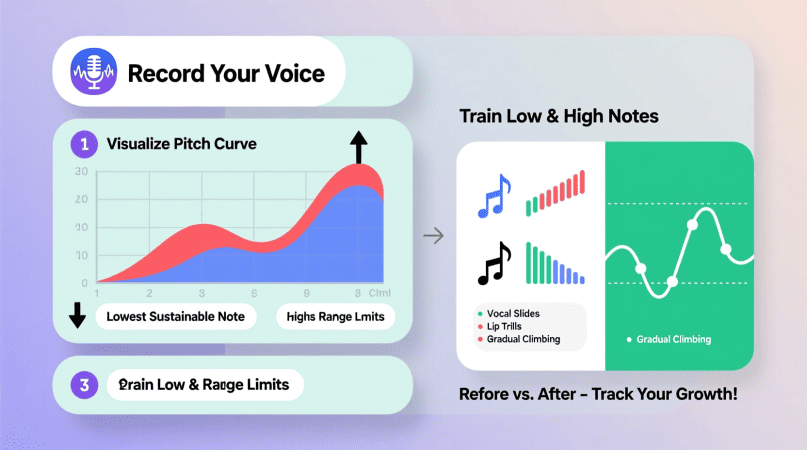
Expanding your vocal range takes consistent training and real-time feedback so you can hit new notes safely and accurately. The Voice Pitch Analyzer helps singers visualize progress while training both low and high registers.
This guide covers range-building exercises and shows how to use the analyzer for safe, effective vocal range growth.
Why Vocal Range Training Needs Feedback
- Prevent strain: Visual pitch feedback helps avoid pushing too hard on high notes.
- Build consistency: Track accuracy across your full range, not just the middle voice.
- Develop flexibility: Switch smoothly between chest, mixed, and head registers.
With the Voice Pitch Analyzer, you see note names, ±cents deviation, and pitch stability instantly.
Getting Started
- Open the Tool: Voice Pitch Analyzer
- Allow Microphone Access: All processing is local for privacy.
- Start with Warm-ups: Gentle lip trills or humming reduce vocal strain.
- Sing Slowly: Move note by note, watching accuracy before adding power or speed.
Low Note Training
Exercise 1: Chest Voice Anchors
- Sing descending scales starting from mid-range to low notes.
- Hold each note for 2–3 seconds; keep ±cents readings near zero.
Exercise 2: Resonance Boost
- Use “ng” or humming sounds for better resonance at low pitches.
- Watch the analyzer to avoid flat notes caused by weak breath support.
High Note Training
Exercise 3: Siren Glides
- Start on a comfortable note; glide upward on “oo” or “ee.”
- Avoid strain — focus on smooth transitions between registers.
Exercise 4: Top Note Holds
- Sustain your highest comfortable note for 2–3 seconds.
- Check ±cents stability; don’t sacrifice pitch for loudness.
For whistle register or extreme highs, see Whistle & High Register Detection Tips.
Mixed & Head Voice Coordination
Exercise 5: Bridge Training
- Sing ascending scales slowly through your passaggio (vocal bridge).
- Keep notes centered on pitch during register changes.
Quick Recap Table
| Exercise Name | Range Focus | Purpose |
|---|---|---|
| Chest Voice Anchors | Low range | Pitch stability on low notes |
| Resonance Boost | Low range | Stronger tone & clarity |
| Siren Glides | High range | Smooth transitions, no strain |
| Top Note Holds | High range | Accuracy on sustained highs |
| Bridge Training | Mid → High | Register coordination |
Common Problems & Fixes
- Pitch drops on low notes: Use stronger breath support, avoid breathiness.
- Strain on high notes: Keep neck and jaw relaxed, reduce volume if needed.
- Pitch flicker in upper range: Use shorter phrases; increase note length gradually.
FAQs
1. How often should I train range?
3–4 short sessions per week; avoid daily high-intensity training to prevent strain.
2. Can I use the analyzer for vocal bridges?
Yes, it shows pitch accuracy during register transitions.
3. What about extreme whistle notes?
See Whistle & High Register Detection Tips for setup advice.
4. Does range expansion require a teacher?
Beginners should consult a vocal coach for safe high-range development.
Pitch Detector is a project by Ornella, blending audio engineering and web technology to deliver precise, real-time pitch detection through your browser. Designed for musicians, producers, and learners who want fast, accurate tuning without installing any software.
